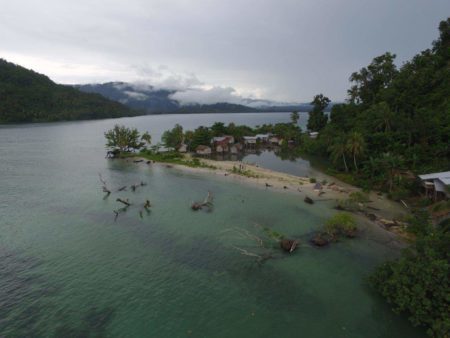October 18, 2019 – A number of Pacific islands forming part of the Solomon Islands chain are disappearing. Five have already vanished, and six more have lost 20% of their landmass since 1947. Why? A combination of sea-level rise and wave action has impacted these islands that vary in size from one to five hectares (2.5 to 12.3 acres).
The seas of the Pacific Ocean are rising between 3 and 5 millimeters (0.12 to 0.2 inches) annually. At the upper end of the scale, that’s a rise of up to one inch every five years. But sea-level rise isn’t uniform across the Pacific. In fact, near the Solomons, seas are rising three times the average. That means up to 0.6 inches annually or a half-foot per decade.
Most of the islands lost are barrier reef islands lying off larger landmasses. Most were heavily vegetated. Some were even permanent homes to people of the island chain.
Over 1,000 predominantly volcanic islands make up the Solomon chain. The tallest elevations reach 500 meters (1,640 feet). The islands are home to 560 000 spread across 28 000 square kilometers (approximately 10,800 square miles).
Where do Solomon Islanders live? Largely in low-lying coastal areas where the land is flat enough to cultivate crops and raise livestock. The most densely populated areas of the Solomans are the reef islands because they are the flattest terrain.
Kale, Rapita, Rehana, Kakatina, and Zollies are the islands that have vanished. And the ones in danger of disappearing are Hetaheta, Sogomou, Nuatambu, Sogomou Ite, Sasashura Ite, and Sasashura Fa.
Can anything save the islands most in danger of vanishing?
What the waves take they can also give back with accretion occurring in some island areas. But the saviour of the chain could be plate tectonics.
The Solomon Islands sit in a tectonically active area of the globe where the Pacific and Australian Plates intersect causing crustal deformation and uplift. So many of the islands of the chain may still have a long life ahead of them which may, in the end, save them from vanishing.
But that may not save the natural wildlife of the islands from completely becoming extinct. With the largest rookery of Hawksbill Turtles in the Pacific currently in danger of disappearing, the Solomon Islanders and researchers are trying to come up with rescue plans. So far nothing for the turtles.
But for the humans whose homes and communities are vanishing, there are rescue plans already underway.
On Nuatambu, more than 50% of homes have washed into the ocean. The residents describe the disappearance of property as incremental rather than sudden. In other words, the relentless upward creep of ocean sea levels is the cause. Some families have relocated to a higher neighbouring volcanic island but others continue to cling to Nuatambu, rebuilding their homes on ever-decreasing parcels of land. A social consequence of Nuatambu’s disappearance has been the breaking up of families who have moved in an ad hoc fashion to new locales, with a resulting loss of the community’s cultural cohesion.
That is not the case elsewhere in the Solomons. On another island, Malaita, the village of Mararo has had to move with the entire community relocating to a site 20 meters above sea level keeping their village intact with no loss of social cohesion.
Another town, Taro, on the island of Choiseul, will soon be the first capital city of the Solomons to relocate because of sea-level rise. In fact, Taro will be the first capital city on the planet to succumb to anthropogenic climate change.
Are the Solomon Islands alone?
Hardly.
Fiji, Kiribati, Nauru, the Marshall Islands, Vanuatu, Timor Leste, and Tonga are all facing a climate crisis in the form of sea-level rise. Some areas of these island nations may be uninhabitable by as early as a decade from now. A more optimistic yet dire forecast suggests these island chains will feel the impact at the mid-century mark. Before then, freshwater aquifers will succumb to saltwater intrusions from rising sea levels. And severe weather will cause wave-driven flooding to deplete agricultural land and damage homes and infrastructure.
Hilda Heine, President of The Marshall Islands, was quoted last year in an article in The Washington Post, stating, “It’s a scary scenario for us…We don’t have the luxury of more land or mountains to move to…We are just focused on our survival, and wondering whether we will still be here 30 to 40 years from now.”
For the people of Nuatambu, it isn’t 30 years in the future. It is already happening.









